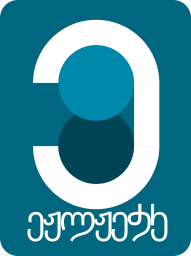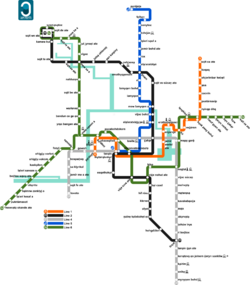Cherrin Metro
 | |||
| Overview | |||
|---|---|---|---|
| Native name | tagảten ḉeryn | ||
| Area served | Cherrin | ||
| Transit type | Rapid transit | ||
| Number of lines | 5 | ||
| Number of stations | 111 | ||
| Operation | |||
| Began operation | 1911 (Line 1) | ||
| Operator(s) | CITOC | ||
| Number of vehicles | 1324 cars; 282 trains | ||
| Train length | 4-6 cars | ||
| Headway | 2–6 minutes (peak) 3-10 minutes (off-peak) 10-40 minutes (night) | ||
| Technical | |||
| Track gauge | 1,320 mm (4 ft 8 1⁄3 in) Sharkunen gauge | ||
| Electrification | 750 V (DC) third rail | ||
| Average speed | 61 km/h (38 mph) | ||
| Top speed | 128 km/h (80 mph) | ||
| |||
Cherrin Metro (Soptenese: tagảten ḉeryn) is a metro system in Soptemia. The system is owned and run by the Cherrin Independent Transit Operating Company (CITOC). It serves as the primary method of public transport in Cherrin and some of the surrounding areas, and connects with numerous bus, tram and rail lines.
The system first opened in 1911, and was expanded rapidly. The Pangyeoun War and Crisis of Succession caused a pause in expansion, but the economic boom caused by The Reform saw even more rapid construction. The system now has 111 stations, with the most recent expansion being the Southwest extension of Line 6 in 2017.
Despite being called a metro, most of the system is above ground. Large portions of the system were converted from main-line railways into metro lines. Though only five lines exist currently, being numbered up to six, and skipping three, there have been up to nine lines at certain times. The extra lines have since been integrated as parts of other lines.
History
The system was first proposed as a way of eliminating congestion both on the streets of Cherrin, and its numerous railway terminals. The system, as originally proposed, would see four lines radiating out from a new central station replacing most or all of the existing railway terminals in the city. In addition, there would be more lines that took over services on existing commuter lines in Cherrin, and running through underground tunnels to this new station.
The system was originally planned, built and operated by a consortium of railways in Cherrin, with significant local government support. Line one opened in 1911 with five stations, serving the northeast of the city. It was built entirely underground, through boring. The new central station, tanạiv mytanạivmyr, opened with it with 6 platforms for metro trains. Lines 2, 3 and 4 all opened in 1913. Line 3 was the line to serve the southwest of the city. Because tanạiv mytanạivmyr was already southwest of the center of Cherrin, line 3 first headed north to serve ohzosqitxil before turning west and south to serve the rest of the southwest of the city. When Line 3 opened, the railway branch that was serving pyrảsyti closed, although line 3 did not utilize its right-of-way, being entirely in bored tunnels.
Lines 2 & 4 both took over existing rail lines, and they each originally operated with existing rolling stock, hauled by electric locomotives. They were built to the standard of main-line railways. Line 2 took over the extremely popular service from ḉakạr to sqit ve sủcaṉ ate. It was bored for the first part of the line, and surfaced just north of where elạixratxizjyjạe is today. ḉakạr was rebuilt as an underground station, and the viaduct running into it was demolished. part of ḉakạr's station building was retained as the entrance to the new station. Line 4 took over service to toveto. It ran along line 3's tracks to just before pyrảsyti, skipping all stations, before branching off. Early on, it was clear that this operating model for these lines was highly inefficient. On line 4, tracks to bypass stations on line 3, as well as new platforms for it at pyrảsyti would be added. Eventually, a new alignment paralleling main line railway tracks would be built. New Electric Multiple Unit trains replaced locomotive-hauled trains on both lines by 1928.
Line 5 was constructed in 1922, serving the Northwest areas of the city, and connecting with the important tosite station. By 1935, Lines 1 and 2 had both extended along existing lines to sqit pe ate, with line 2 providing a limited service. Another line, to be colored red on the map, was planned to run in a loop around sqit ve ate, however, the Pangyeuon War and ensuing economic downturn cased construction of tunnels to be halted, and the existing parts were made into an express tramway.
After the Pangyeoun War, the original plan for the metro was considered obsolete, and new metro lines were built to standards different to those originally set out by the planners. Line 6 opened in stages starting from 1954, serving the southeast. This was the first part of the syetem to use cut-and cover techniques, and the first part to use elevated viaducts for a significant portion. At the same time that line 6 opened, line 7 opened as a shuttle, running surplus rolling stock from line 4 on a shuttle service over previously main line tracks from nogtal to mohvạtạ. Line 8 opened in 1955, taking over parts of the express tramway. In 1960, line 4 opened through the center of the city, taking over both the existing line 4 to the west, as well as line 7 to the east. As lines 4 was built to mainline rail standards, rather than those found on the rest of the metro, the eastern and western sections of line 4 were operated as two different lines for a period, being referred to as line 4-west and 4-east.
In 1967, some mainline rail services terminating at the outskirts of the metro, which had been operating previously, were rebranded as metro services, being called lines 7 and 9. In 1968, lines 1 and 3 were combined. In 1971, line 5 was extended along the tracks of line 2, taking over line 8. In 1975, a new viaduct opened parallel to line 2 on this section, allowing the lines to remain separate. In 1977, line 7 was converted to metro standards, and was taken over in its entirety by line 6 briefly. in 1978 a modernization of line 2 was completed, bringing it to the same standards as all other lines, and was extended to meet line 6, taking over parts of what was formerly line 7. It was planned to have line 1 serve the section between sqit ve sủcaṉ ate and sqit pe ate, but it was found that this line was in worse condition than previously thought, and it was single-tracked and made part of the tram network.
The 1980s and 90s saw extensions of lines 4 and 6, with the latter taking over line 9, and the former finally serving Cherrin-Sanklij International Airport.
Fares
The Cherrin Metro uses a distance-based fare system. Every station is protected by faregates, and this system is fully compatible with other forms of transport in the region.
Lines
| Line | Opened | Termini | Stations | Train length (cars) | ||
|---|---|---|---|---|---|---|
| Color | Name | |||||
| orange | Line 1 | 1911 | pyrảsyti | sqit pe ate | 19 | 4 |
| black | Line 2 | 1913 | lirẹat | Loop | 29 | 6 |
| silver | Line 4 | 1913 | toveto | mynyṉen bohd | 28 | 4 |
| blue | Line 5 | 1922 | tanạiv mytanạivmyr | pyrảjeṯa | 18 | 4 |
| green | Line 6 | 1954 | sqit ze ate | mewvạtạ skande ate, Loop | 43 | 5 |
| total | 111 | |||||
One line is currently under construction. When completed, it will be named 'line 3' and be colored red on the map. It will finally complete the loop that has operated as the express tram. Additionally, line 1 will take over service between sqit ve sủcaṉ ate and sqit pe ate. It is expected to open in 2024. Another line, running between the terminal at the supreme court and nogtal. It has also been proposed to turn this into another full loop.
Stations
There are 111 stations on the Cherrin metro. Under the original plan, all underground stations were architecturally the same, aside from a few exceptions. This was changed with the opening of line 6.
Rolling stock
| Active Rolling Stock | ||||
|---|---|---|---|---|
| Name | Manufacturer | Quantity | Line(s) | Entered Service |
| T449 | 124 | Line 4 | 1960 | |
| T563 | 140 | Line 1(1973-75), Line 5 | 1973 | |
| T2667 | 234 | Line 6, Line 2 | 1976 | |
| T474 | 116 | Line 4 | 1984 | |
| T680 | 225 | Line 6, Line 9(1991-93) | 1990 | |
| T1290 | 280 | Line 1, Line 2 | 2002 | |
| T6405 | 205 | Line 6 | 2016 | |
| Retired Rolling Stock | ||||||
|---|---|---|---|---|---|---|
| Name | Manufacturer | Quantity | Line(s) | Entered Service | Retired | Replaced by |
| T101 | 52 | Line 1 | 1911 | 1955 | T840/T843 | |
| T303 | 22 | Line 3 | 1913 | 1956 | T840/T843 | |
| T512 | 24 | Line 5 | 1922 | 1975 | T563 | |
| T2418 | 126 | Line 2, Line 4, Line 7 | 1928 | 1977 | T449,T2667 | |
| T123 | 24 | Line 1 | 1933 | 1975 | T840/T843 | |
| T840/T843 | 124 | Line 1, Line 3, Line 8, Line 5 | 1951 | 2004 | T1290 | |
| T644 | 140 | Line 6 | 1954 | 2019 | T680, T6405 | |
| Future Rolling Stock | ||||
|---|---|---|---|---|
| Name | Manufacturer | Quantity | Line(s) | Enters Service |
| T4313 | 420-436 | Line 4, Line 3, Line 1 | 2023 | |


